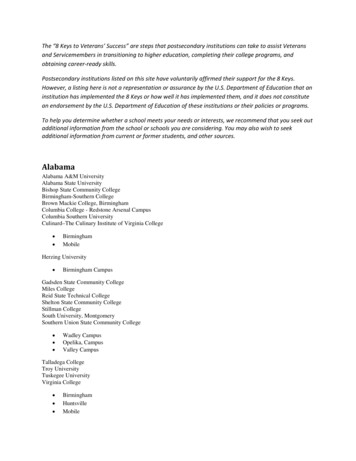
Transcription
The Handbookfor Campus Safetyand Security Reporting2016 Edition
This page intentionally left blank.
The Handbook forCampus Safety andSecurity Reporting2016 EditionU.S. Department of EducationOffice of Postsecondary Education
This report was prepared in part under Contract Nos. ED-04-CO-0059/0004 and ED-99-CO-0109 withWestat and ED-OPE-15-C-0031 and ED-IES-10-C-0016 with INOVAS. Amy Wilson served as thecontracting officer’s representative. No official endorsement by the U.S. Department of Education of anyproduct, commodity, service or enterprise mentioned in this publication is intended or should be inferred.U.S. Department of EducationJohn B. King, Jr.SecretaryOffice of Postsecondary EducationLynn MahaffieDeputy Assistant Secretary for Policy, Planning, and Innovation, delegated the authority to perform thefunctions and duties of the Assistant Secretary for Postsecondary EducationPolicy Development, Analysis and Accreditation ServiceGail McLarnonSenior DirectorJune 2016This report is in the public domain. Authorization to reproduce it in whole or in part is granted. Whilepermission to reprint this publication is not necessary, the citation should be U.S. Department ofEducation, Office of Postsecondary Education, The Handbook for Campus Safety and Security Reporting,2016 Edition, Washington, D.C., 2016.This report is available on the Department’s website .Availability of Alternate FormatsOn request, this publication is available in alternate formats, such as Braille, large print or computerdiskette. For more information, please contact the Department’s Alternate Format Center at 202-260-0852or by contacting the 504 coordinator via email at om eeos@ed.gov.Notice to Limited English Proficient PersonsIf you have difficulty understanding English, you may request language assistance services forDepartment information that is available to the public. These language assistance services are availablefree of charge. If you need more information about interpretation or translation services, please call1-800-USA-LEARN (1-800-872-5327) (TTY: 1-800-437-0833), email us atEd.Language.Assistance@ed.gov, or write to U.S. Department of Education, Information ResourceCenter, 400 Maryland Ave. SW, Washington, DC 20202.Photo creditsFront cover: Upper left, Shutterstock; upper center top and bottom, Westat; upper right, Getty Images;bottom, Getty Images; page 6-5, Westat; back cover: upper left, Getty Images; middle and lower left,Westat; center, Getty Images; right, Shutterstock. The republication, retransmission, reproduction or otheruse of these photos independent of The Handbook for Campus Safety and Security Reporting isprohibited.Content contact: HandbookQuestions@ed.gov
CONTENTSAbbreviations .viList of Figures .viiList of Tables .vii1.Introduction: An Overview of Campus Safety and Security Reporting .1-1How to Determine If Your Institution Must Comply With the HEA .Purpose of the Handbook .Getting Additional Help .1-21-41-11Geography: Location, Location, Location .2-1How to Identify Your On-campus Geography .How to Identify Your Public Property .How to Identify Your Noncampus Buildings or Property .Use of Maps.2-22-112-182-26Crime Statistics: Classifying and Counting Clery Act Crimes .3-1Crime Definitions .Types of Criminal Offenses .Hate Crimes .VAWA Offenses .Arrests and Disciplinary Referrals for Violation of Weapons, DrugAbuse and Liquor Laws .Unfounded Crimes .Excluded Crimes .3-33-43-253-36Collecting Statistics: Authorities and Law Enforcement Agencies .4-1How to Identify Your Institution’s CSAs .What Does a Campus Security Authority Do? .What Shouldn’t a Campus Security Authority Do? .Exemption for Pastoral and Professional Counselors .Recommendations .Requesting Statistics From Local Law Enforcement Agencies .4-24-54-64-74-94-12The Daily Crime Log: Recording Crimes Reported to Campus Police orSecurity Personnel .5-1Purpose of the Daily Crime Log.Creating Your Log.Required Crime Log Elements .Maintaining Your Log .Making Your Log Available .5-25-45-45-65-72.3.4.5.The Handbook for Campus Safety and Security Reporting3-423-513-55iii
6.7.8.Emergency Notification and Timely Warnings: Alerting Your CampusCommunity .Emergency Response and Evacuation Procedures .The Timely Warning .Emergency Notification and Timely Warnings: Sorting Out theDifferences .6-16-12Policy Statements: What You Do and How You Do It .7-1Campus Security Policies That Must Be Addressed in the AnnualSecurity Report .7-2Policies, Procedures and Programs: Dating Violence, DomesticViolence, Sexual Assault and Stalking.8-1Educational Programs and Campaigns .Procedures Victims Should Follow in the Case of Alleged DatingViolence, Domestic Violence, Sexual Assault or Stalking .Procedures Your Institution Will Follow in the Case of Alleged DatingViolence, Domestic Violence, Sexual Assault or Stalking .Advising the Campus Community About Sex Offenders .9.10.11.12.iv6-1The Annual Security Report: Publishing Policy Statements and CrimeStatistics.6-168-38-98-128-239-1Presenting Your Policy Statements in the Annual Security Report .Presenting General Crime Statistics and Arrest and DisciplinaryReferral Statistics .Presenting Hate Crime Statistics in the Annual Security Report .Presenting Statistics for Unfounded Crimes in the Annual SecurityReport .9-29-6Missing Students: The Twenty-four Hour Rule .10-1Policy Statement .Procedures .10-210-5Fire Safety Disclosures: Requirements and Definition of a Fire.11-1Definition of a Fire .11-1The Fire Log: Recording Fires in On-campus Student HousingFacilities .12-1What Are Reported Fires? .Creating a Fire Log.Reporting to the Campus Community .12-112-312-5The Handbook for Campus Safety and Security Reporting9-29-7
13.14.Fire Statistics: Classifying and Counting Fires in On-campus StudentHousing Facilities .13-1Required Fire Statistics .13-1The Annual Fire Safety Report: Publishing Policy Statements and FireStatistics.14-1Components of the Fire Safety Report .14-2AppendicesALinks to the Higher Education Act of 1965 Safety- and Security-relatedLaws and Regulations .A-1BSample Letter to a Local Law Enforcement Agency to Request CrimeStatistics.B-1CChecklist for Campus Safety and Security Compliance .C-1Index .The Handbook for Campus Safety and Security ReportingI-1v
ABBREVIATIONSAD: Athletics directorClery Act: Jeanne Clery Disclosure of Campus Security Policy andCampus Crime Statistics ActClery Act geography: Buildings or property that meet the definition ofOn Campus, Public Property, or Noncampus buildings orproperty as defined by the Clery Act and discussed in Chapter 2of this handbookCSA: Campus Security AuthorityDUI: Driving under the influenceDWI: Driving while intoxicatedFERPA: Family Educational Rights and Privacy ActFBI: Federal Bureau of InvestigationFSEOGs: Federal Supplemental Educational Opportunity GrantsGO: General orderHEA: Higher Education Act of 1965LEAP: Leveraging Educational Assistance PartnershipMOU: Memorandum of UnderstandingNIBRS: Uniform Crime Reporting National Incident-Based ReportingSystemPPA: Program Participation AgreementRA: Resident assistantSOP: Standard operating procedureThe Department: U.S. Department of EducationUCR: Uniform Crime ReportingVAWA: Violence Against Women ActviThe Handbook for Campus Safety and Security Reporting
FIGURES1.Example of public property: sidewalk, street, sidewalk .2-132.Example of public property: parking lot .2-143.Example of public property: gated fence .2-174.Example of noncampus location: mixed-use apartment building .2-245.Suggested Training Elements for Campus Security Authorities .4-116.Sample Daily Crime Log With Required Elements .5-47.Example of Emergency Notification via Text Message .6-58.Sample Scenarios Regarding Emergency Notification and theTimely Warning .6-179.Sample Criminal Offenses Reporting Table .9-410.Sample VAWA Offenses Reporting Table.9-511.Sample Arrests and Disciplinary Referrals Reporting Table .9-512.Examples of Descriptive Hate Crime Reporting .9-613.Examples of Descriptive Unfounded Crime Reporting .9-714.Examples of Reported Fires .12-215.Sample Fire Log With Required Elements .12-416.Classifications of Fire and Examples.13-217.Value Ranges for Estimated Property Damage Due to Fire .13-518.Sample Fire Statistics Reporting Table for the Annual Fire SafetyReport .13-719.Sample Description of On-campus Student Housing Facility FireSafety Systems .14-3TABLES1.Components of Higher Education Act compliance regardingcampus safety and security reporting: Basic requirements and timeframes .The Handbook for Campus Safety and Security Reporting1-9vii
This page intentionally left blank.
Introduction:An Overview of Campus SafetyAnd Security ReportingCHAPTER1Choosing a postsecondary institution is a major decision forstudents and their families. Along with academic, financial andgeographic considerations, the issue of campus safety is a vitalconcern. In 1990, Congress enacted the Crime Awareness andCampus Security Act of 1990 (Title II of Public Law 101-542),which amended the Higher Education Act of 1965 (HEA). Thisact required all postsecondary institutions participating inHEA’s Title IV student financial assistance programs todisclose campus crime statistics and security information. Theact was amended in 1992, 1998, 2000 and 2008. The 1998amendments renamed the law the Jeanne Clery Disclosure ofCampus Security Policy and Campus Crime Statistics Act inmemory of a student who was slain in her dorm room in 1986.It is generally referred to as the Clery Act and is in section485(f) of the HEA.On March 7, 2013, the Violence Against WomenReauthorization Act of 2013 (VAWA) (Public Law 113-14) wassigned into law. VAWA includes amendments to the Clery Act.These changes require institutions to disclose statistics, policiesand programs related to dating violence, domestic violence,sexual assault and stalking, among other changes. Specifically,these changes added or modified requirements related to disclosure of statistics of the number of datingviolence, domestic violence, sexual assault andstalking incidents; disclosure of statistics of new categories of HateCrimes; implementation by institutions and disclosure ofprograms to prevent dating violence, domesticviolence, sexual assault and stalking, including–primary prevention and awareness programs forincoming students and employees; andThe Handbook for Campus Safety and Security Reporting1-1
Chapter 1. Introduction: An Overview of Campus Security–Although the HEAis the law thatgoverns theadministration ofall federal highereducationprograms, asused in thishandbook, HEArefers only to theClery Act andother safety- andsecurity-relatedrequirementsapplicable toinstitutions underthe HEA.1-2ongoing prevention and awareness campaignsfor students and employees; disclosure of procedures victims should follow if acrime of dating violence, domestic violence, sexualassault or stalking has occurred; and implementation by institutions and disclosure ofprocedures for institutional disciplinary action incases of dating violence, domestic violence, sexualassault and stalking, including–descriptions of each disciplinary proceedingused by the institution, the standard of evidenceused during each disciplinary proceeding,possible sanctions imposed following theresults of disciplinary proceedings, and therange of protective measures that the institutionmay offer a victim;–provisions to ensure that proceedings will beprompt, fair and impartial;–provisions that state that proceedings will beconducted by officials who receive annualtraining; and–ensuring equal opportunities for the accuserand accused to have others present duringproceedings, including an advisor of theirchoice.Although the HEA is the law that governs theadministration of all federal higher education programs, asused in this handbook, HEA refers only to the Clery Act andother safety- and security-related requirements applicable toinstitutions under the HEA.How to Determine If Your InstitutionMust Comply With the HEADoes your institution participate in federal Title IVstudent financial assistance programs? All public and privatepostsecondary institutions that participate in any of the Title IVprograms must comply with the HEA. Title IV institutions havesigned Program Participation Agreements (PPAs) with the U.S.The Handbook for Campus Safety and Security Reporting
Chapter 1. Introduction: An Overview of Campus SecurityDepartment of Education (the Department) to administer thesefinancial assistance programs. The programs include PellGrants, Federal Supplemental Educational Opportunity Grants(FSEOGs), the Federal Work-Study Program, Federal PerkinsLoans, the Federal Direct Loan Program, and the LeveragingEducational Assistance Partnership (LEAP). If you are not surewhether your institution participates in the Title IV programs,contact your institution’s financial aid officer or chiefexecutive officer.Note that: Your institution must comply with the HEA’srequirements beginning on the date your PPA goesinto effect (i.e., the date it is signed by the secretaryof education). If your institution is Title IV eligible,but has a location or locations that serve students whoare not receiving Title IV student aid, you must stillcomply with the Clery Act and other safety- andsecurity-related HEA requirements for all locations.These requirements apply based on institutionaleligibility, not location eligibility. If your institution primarily serves secondary schoolstudents, but enrolls even one postsecondary schoolstudent and participates in the Title IV programs, youmust comply. If your institution does not participate in the Title IVprograms or has a “deferment only” status (i.e., itdoes not provide student loans or grants through TitleIV programs but does have students who are eligibleto defer federal student loans while they are enrolledin your school), you are not required to comply withthe requirements described in this handbook.Title IV institutions that are exempt fromcompliance: If your institution is a distance education-onlyschool and your students are never present on aph
students and their families. Along with academic, financial and geographic considerations, the issue of campus safety is a vital concern. In 1990, Congress enacted the Crime Awareness and Campus Security Act of 1990 (Title II of Public Law 101-542), w










